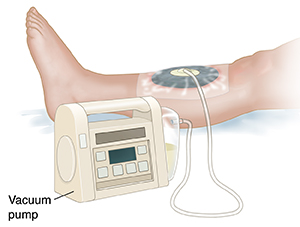Negative Pressure Wound Therapy
Negative pressure wound therapy (NPWT) is a type of treatment to help wounds heal. It's also known as vacuum-assisted wound closure or wound VAC. During the treatment, a device lowers air pressure on the wound. This can help the wound heal more quickly.
Understanding NPWT
A NPWT device has several parts. A foam or gauze dressing is put directly on the wound. The dressing is changed every 24 to 72 hours. An adhesive film covers and seals the dressing and wound. A drainage tube leads from under the adhesive film and connects to a portable vacuum pump. This pump removes air pressure over the wound, and it also helps drain any fluid from the wound. It may do this constantly. Or it may do it in cycles. During the treatment, you’ll need to carry the portable pump everywhere you go.

Why NPWT is used
You might need this therapy for a recent traumatic wound. Or you may need it for a chronic wound. This is a wound that does not heal the way it should over time. This can happen with wounds in people who have diabetes. You may need NPWT if you’ve had a recent skin graft. And you may need it for a large wound. Large wounds can take a longer time to heal.
NPWT may help your wound heal more quickly by:
-
Draining extra fluid from the wound
-
Reducing swelling
-
Reducing bacteria in the wound
-
Keeping your wound moist and warm
-
Helping draw together wound edges
-
Increasing blood flow to your wound
-
Decreasing inflammation
NPWT offers some other advantages over other types of wound care. It may decrease your overall discomfort. The dressings usually need to be changed less often. And they may be easier to keep in place.
Risks of NPWT
NPWT has some rare risks, such as:
-
Bleeding, which may be severe
-
Wound infection
-
An abnormal connection between the intestinal tract and the skin (enteric fistula). This is usually a problem only if the NPWT is used on an open belly wound that was unable to be closed.
Proper training in dressing changes can help reduce the risk for these complications. Also, your healthcare provider will carefully evaluate you to make sure you are a good candidate for the therapy. Certain problems can increase your risk for complications. These include:
-
Exposed organs or blood vessels
-
High risk of bleeding from another medical problem
-
Wound infection
-
Nearby bone infection
-
Dead wound tissue
-
Cancer tissue
-
Fragile skin, such as from aging or longtime use of topical steroids
-
Allergy to adhesive
-
Very poor blood flow to your wound
-
Wounds close to joints that may reopen because of movement
Your healthcare provider will discuss the risks that apply to you. Make sure to talk with them about all your questions and concerns.
Getting ready for NPWT
You likely won’t need to do much to get ready for your wound therapy. In some cases, you may need to wait a while before having this therapy. For example, your healthcare provider may first need to treat an infection in your wound. Dead or damaged tissue may also need to be removed from your wound.
You or a caregiver may need training on how to use the NPWT device. This is done if you will be able to have your wound vacuum therapy at home. In other cases, you may need to have your wound vacuum therapy in a healthcare facility.
On the day of your procedure
A healthcare provider will cover your wound with foam or gauze wound dressing. An adhesive film will be put over the dressing and wound. This seals the wound. The foam connects to a drainage tube, which leads to a vacuum pump. This pump is portable. When the pump is turned on, it draws fluid through the foam and out the drainage tubing. The pump may run constantly, or it may cycle off and on. Your exact setup will depend on the specific type of wound vacuum system that you use.
Managing your wound
You may need the dressing changed about once a day, or less often, such as every few days. You may need it changed more or less often, depending on your wound. You or your caregiver may be trained to do this at home. Or it may be done by a visiting healthcare provider. Your provider may prescribe a pain medicine. This is to prevent or reduce pain during the dressing change.
You will likely need to use the NPWT system for several weeks or months to allow the wound to heal. During this time, you’ll carry the portable pump everywhere you go.
Nutrition for wound healing
During this time, make sure you follow a healthy diet. This is needed so the wound can heal and to prevent infection. Your healthcare provider can tell you more about what to include in your diet during this time.
Follow up with your healthcare provider if you have a medical condition that led to your wound, such as diabetes. Your provider can help you prevent future wounds.
Follow-up care
Your healthcare provider will carefully keep track of your healing. Make sure to keep all follow-up appointments. This can include measuring the size of the wound and taking pictures of it.
When to call your healthcare provider
Call your healthcare provider right away if you have any of these:
-
Fever of 100.4°F (38.0°C) or higher, or as directed by your healthcare provider
-
Chills
-
Increased redness, swelling, or warmth around the wound
-
Increased pain
-
Bright red blood or blood clots in tubing or the collection chamber of the NPWT device